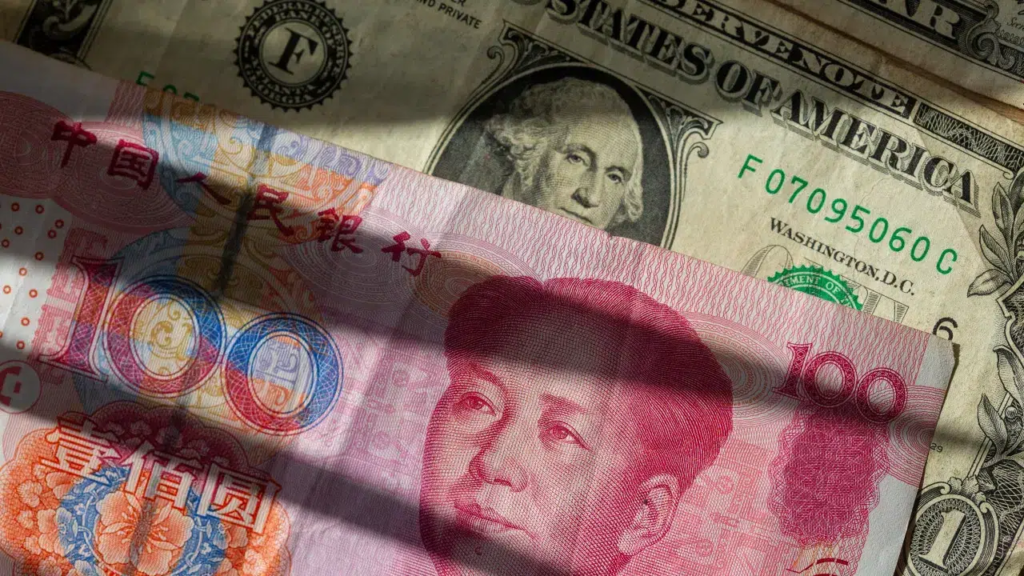Chinese Yuan Plunges to Lowest Level in 18 Years
The Chinese yuan has fallen to its lowest level in 18 years. This drop is mainly due to rising trade tensions between the United States and China.

On April 9, 2025, the onshore yuan closed at 7.3498 per U.S. dollar. This is its weakest point since December 2007. The offshore yuan also hit record lows during overnight trading. This shows growing instability in currency markets.
Key Drivers Behind the Decline
U.S. Tariff Increases
President Donald Trump raised tariffs on Chinese goods to as much as 104%. These steep tariffs increased economic pressure on China. They disrupted trade flows and weakened the yuan.
China’s Retaliatory Measures
In response, China raised tariffs on U.S. goods to 84%. This tit-for-tat action fueled the trade conflict further. It increased market uncertainty and added to the yuan’s fall.
Domestic Economic Challenges
China’s economy faces many challenges. These include a real estate crisis, weak domestic demand, and the lingering effects of COVID-19. Global demand for Chinese exports has also fallen. This has added to the strain.
Capital Outflows
Tensions with the U.S. have triggered capital outflows. Many foreign investors have reduced their investments in China. This has worsened pressure on the yuan.
Central Bank Policy
The People’s Bank of China (PBOC) has allowed the yuan to weaken gradually. This supports exporters during the trade war. However, the PBOC has stepped in lightly to prevent sharp declines that could harm financial stability.
Implications and Outlook
A weaker yuan makes Chinese goods cheaper overseas. This can help offset some losses from tariffs. But economists warn that too much depreciation could lead to capital flight and financial risks.
Market Stability Efforts
The PBOC is guiding the currency lower in controlled steps. It has also set reference rates stronger than expected. This signals its aim to keep the market stable. In addition, state-owned banks have been told to limit dollar purchases to slow the yuan’s fall.

Analysts expect the yuan to weaken slightly in the short term. However, sharp declines are unlikely due to central bank interventions. The yuan’s long-term recovery depends on China’s economic growth and improved ties with other countries.
A Historical Slide
The yuan’s value has long reflected China’s economic health. In the 1990s, it was tightly pegged to the U.S. dollar. But in 2005, China allowed it to move within a managed range. This change aimed to reflect market forces while ensuring stability.
The yuan has survived past crises. These include the 2008 global financial crisis and the 2015 devaluation scare. Yet, today’s level is a new low. It has fallen below the 7.3510 mark last seen in September 2023.
In early 2023, the yuan traded around 6.8 per dollar. Hopes for post-pandemic recovery kept it strong. But several problems have since weakened it. These include property sector troubles, falling consumer demand, and now, U.S. tariffs of up to 104%.
Why Now?
The latest trigger for the yuan’s fall is the U.S. tariffs. These target a wide range of Chinese goods, from electronics to machinery. This follows a pattern of trade disputes that began in 2018.
President Trump says these tariffs are meant to counter unfair trade practices. In some reports, tariffs rose overnight from 104% to 125%. This threatens China’s export-driven economy.
Beijing’s strategy also plays a role. The PBOC recently set the yuan’s daily midpoint at 7.2092. This is its weakest level since September 2023. It shows China is willing to let the yuan fall to help exporters.
Economists Weigh In
Analysts have mixed views. Societe Generale says China prefers a slow, controlled depreciation. It helps maintain investor confidence. But they warn tariffs alone could cost China billions in lost trade.
Goldman Sachs predicts China may cut interest rates later this year. However, deflation could make this more difficult.
Some fear a falling yuan could spark a regional currency war. Other Asian countries might devalue their currencies to stay competitive. This recalls the 1997 Asian financial crisis — a scenario China wants to avoid.
Chinese Officials Respond
Chinese authorities are staying cautious. The PBOC has intervened to slow the yuan’s fall. State-owned banks have sold dollars in local markets to help.
Read this:
However, the PBOC’s daily midpoint rate remains stronger than market forecasts. This shows China does not want the yuan to collapse completely. Officials have promised to prevent excessive currency volatility.
Top officials are set to meet soon. Their goal is to create policies to support the economy. A key focus is boosting domestic demand to reduce reliance on exports.
What’s Next?
As the yuan stays near multi-decade lows, the world is watching closely. Cheaper Chinese goods may flood markets, increasing trade disputes. Investors will look for signs of capital outflows that could harm China’s financial system.
For now, China walks a fine line. It must balance helping exporters with maintaining economic stability in the face of an ongoing trade war.


 Elon Musk Pulls Back After Trump Post Controversy
Elon Musk Pulls Back After Trump Post Controversy  Is Trump Hyping Troops on U.S. Soil to Crush LA Protests?
Is Trump Hyping Troops on U.S. Soil to Crush LA Protests?  What’s Behind the Immigrant Protests in Los Angeles?
What’s Behind the Immigrant Protests in Los Angeles?  How Elon Musk and Trump’s Bromance Turned Bitter
How Elon Musk and Trump’s Bromance Turned Bitter